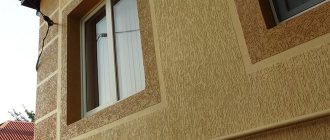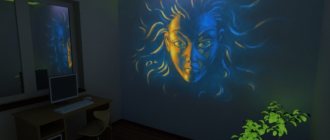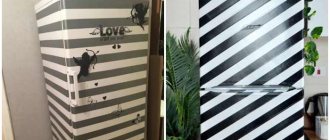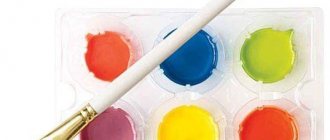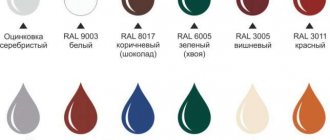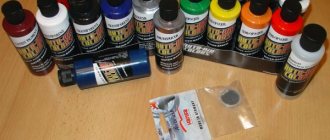Carrying out repair work is a responsible and quite difficult task. Every person wants their home to look individual and unique. That is why, for apartment renovation, non-standard colors and shades of paint are selected, which in construction stores, despite the wide selection of paints and varnishes, are extremely difficult, and sometimes even impossible, to find.
Read also: Finnish varnishes and paints TEKNOS "Teknos"
The only way to get the desired shade is to tint yourself. Large hardware stores also offer services for producing paints and varnishes of the required tone, using computer tinting. To do this, you just need to select the desired color from the proposed samples, and the program itself will calculate the percentage of paint and tint. This will allow you to create the most suitable tone that will fit perfectly and organically into the interior of the room. But not everyone knows how to tint paint to achieve the desired result.
Palette for coloring
Advantages of tinting over buying ready-made paint
- The ability to create colors that simply aren't available in the stores you visit. In fact, the range of many of them is very limited and is represented by paints of the most popular colors. If you want to go beyond the standard, then tinting is often the only option;
- The paint has bulged and needs to be replaced, or there simply wasn’t enough to complete the finish. You need additional paint, but the city stores don’t have it, and there’s no time for a more detailed search. The situation is very common, and here precise selection of colors can solve the problem;
- Tinting is used if you need to choose shades that are in harmony with each other as part of the decoration of the room.
Advantages and disadvantages of computer tinting
Now there are special machines that allow tinting work to be carried out automatically. The use of these devices has the following advantages:
- Getting rid of the human factor. If by manually selecting the tone you can make a mistake and go too far, which happens quite often, then the robot does not allow such mistakes;
- Selected color parameters can be reused - the final product will be exactly the same;
- A large number of flowers;
- The disadvantage is that it is tied to a specific location and the inability to carry out work directly on site. Moreover, not everyone lives in big cities where such devices are available.
Advantages and disadvantages of manual tinting at home
- Tinting machines can create a variety of colors, but complex and individual shades are difficult to achieve. Man will always be limited by standards;
- Possibility to carry out paint creation work on site. During a designer renovation this can be very important;
- Saving time and money. The color itself is very inexpensive, and white paint also does not belong to the category of expensive materials.
- The disadvantage is the high probability of making mistakes in the absence of experience. Additionally, getting the color back can also be a challenge. Sometimes, having re-applied the resulting color next to a previously painted surface, we immediately notice a difference, and a very significant one.
Manual tinting - counting ingredients
In order not to mess up the color, you will need a pen and a piece of paper, as well as all the reserve of attentiveness that you have. You also need to provide yourself with variability, so prepare several pieces of dishes, the same in volume and always clean. The ideal solution is yogurt jars.
It is necessary to record how much paint you pour into the jars and how much color you use to change the color. It is necessary to understand that the color itself is an extremely saturated pigment concentrate, so it must be added carefully. It is best to start with two drops, after which, if you are dissatisfied with the result, add drop by drop. It is necessary to mix everything very well so that the pigment dissolves thoroughly.
When applying paint to a wall or other surface in test mode, you need to understand that after drying the color will appear more strongly. So before painting, you can create a paler shade than the one you want to achieve. Having assessed the result after drying and thus obtained a recipe, you can use it to tint the rest of the paint.
But here you need to understand that with a large amount of paint, the volume must be reduced by 20 percent, since a large painted surface always looks brighter than a small one. Therefore, if in your recipe it turns out that you need to add 100 drops of color per liter, it is better to get by with 80 drops.
How to tint paint by hand correctly to get the exact color?
Today I will write about tinting paint by hand... A trivial situation: there was not enough paint of the desired shade, but it is needed urgently to complete the job. What to do? There is a way out if you have a similar light paint on hand, which can be tinted with construction colors or other shades of paint from the same manufacturer. A dark foundation is suitable if you need a dark, rich shade.
_______________ I won’t go into detail about exactly which shades I mixed, I’ll only tell you the basic principles of how to quickly achieve the desired result. I mixed Verny eco-paint Perfect based on white paint in the color “Porcelain”. It was necessary to get paint of a warm sand shade.
I mixed Verny eco-paint Perfect based on white paint in the color “Porcelain”. It was necessary to get paint of a warm sand shade.
So, let's get started: ______________ 1. Prepare the main paint (Base) for mixing and construction colors and (or) paints of different shades for tinting (let's call them Colors).
2. On a piece of white paper we make several paint marks of the shade we need (Goal). This is a very important point! If there is no paint left at all, or it is only on the product, it will be more difficult to match the tone.
3. Pour some base paint into a small container and begin adding colors to it, carefully, preferably drop by drop. We remember which colors are involved in mixing and make notes on paper.
4. When it seems to us that the color is close to the goal, we paint next to what is on the paper. Be sure to dry the paint before checking, because... In its raw form, the shade of paint is usually different.
5. If our colors do not match, add more colors drop by drop and adjust the color intensity. We rely on intuition and experience! It won’t be possible right away, but we are carefully moving towards the goal.
6. We constantly paint, dry, check, make notes and achieve the desired result!
When we have achieved an exact match and understand what shades of paint our goal consists of, we can begin tinting the required volume of paint. 1. Take a container of the required volume with a lid, where we will mix everything. I had 500 ml. glass jar. 2. We repeat all the steps that we have already done earlier, but in this jar, where we will pour the base paint. At each stage, thoroughly mix the paint and check our notes on what needs to be added. 3. When we reach a goal, we admire it. 4. You can also visually compare the paint in both cans, the base and the resulting one. 5. It is recommended to mix the paint you prepared yourself and the base paint in one container, this way we will achieve even greater color matching.
1. Take a container of the required volume with a lid, where we will mix everything. I had 500 ml. glass jar. 2. We repeat all the steps that we have already done earlier, but in this jar, where we will pour the base paint. At each stage, thoroughly mix the paint and check our notes on what needs to be added. 3. When we reach a goal, we admire it. 4. You can also visually compare the paint in both cans, the base and the resulting one. 5. It is recommended to mix the paint you prepared yourself and the base paint in one container, this way we will achieve even greater color matching.
Important! You need a lot of dry brushes, so that each new color can be done with a new brush and you don’t have to wash the brush all the time, or you can use cotton swabs, for example. By learning how to tint paint, you will significantly expand your creative capabilities. But remember that colors can be added no more than 30% of the original volume of paint, otherwise you can change the properties of the paint and it may start to get dirty. For this reason, it is quite difficult to manually tint a dark, rich shade; the paint may remain whitish. I recommend always buying dark shades ready-made. In professional tinting using special equipment for tinting paint in dark colors, a certain type of base paint without white pigments is used. It is quite difficult to tint paint if the task is to get exactly the required shade. Therefore, it is better to buy paint with a reserve! When we tinted 4 liters of paint to paint the doors, it took about two hours, and rather unusual tint colors were involved in obtaining the desired beige shade: red and blue (see photo). If during the work it turns out that there is definitely not enough paint, and you will need to tint it, try to paint parts of the product so that the possible discrepancy in shade is not too noticeable (for example, different sides of doors, different halves of furniture, which are not visible). Well, leave some paint in the paint can. The photographs show 2 different episodes of paint tinting.
If you have any questions, write in the comments, I will be happy to answer!
Sincerely,
Oksana Loven
Two types of colors
All colors are divided into two types, which we will describe below:
- Organic. Typically, the shades obtained using these pigments are brighter and richer. However, these tinting systems have disadvantages. So, they are not suitable for all types of surface. In addition, the paint modified with their help fades over time in the sun.
- Inorganic. Much more resistant to solar radiation and atmospheric influences, but at the same time much less varied in the choice of colors.
Forms of color release
- Today there are several forms of tinting systems on the market, which have their own advantages and disadvantages:
- Color paints. In terms of their chemical composition, they are completely identical to the paints to which they are added. By gradually adding colorant to white paint, you can get almost any shade. If you want to get the brightest color possible, then you can use the colorant itself as a coating material. True, this will not be very economical, so it is better to paint limited surface areas in this way;
- Color pastes. They are a pigment diluted in a dispersing resin, or without a binder component. The advantages of this paste include its ease of use, but the disadvantage is the lack of uniform intensity. Available for all types of paints, and in a more highly specialized form;
- Dry colors. They are inexpensive, but are not recommended for use with ready-made paints, and also have a rather small color palette.
Useful tips and tricks
Currently, the market for paints and varnishes offers a wide range of colors from both foreign and domestic manufacturers. At the same time, Russian products are not inferior in quality to foreign analogues, and their cost is an order of magnitude lower.
To obtain a higher quality color that is closest to the desired color, it is advisable to use snow-white paint without the characteristic yellowish tint as a base.
It is better to add dye in small portions, since even a small amount can significantly change the color of the paint. It is advisable that the color of the surface to be painted be light in tone, or even better, white, since even after applying several layers of paint, the dark background will be noticeable.
Before you begin directly painting the surface, it is necessary to carry out a number of preparatory measures. From the surface you need to remove dirt, remnants of the previous coating, mold, etc. If there are uneven spots on the wall, then you need to plaster it.
Tinting and various types of paint
When tinting, it is necessary to take into account the types of paint with which the color will be mixed. Of course, there are now universal options on the market, but when working with this or that paint, you still need to follow some rules:
- Acrylic paint. Here it is necessary to remember about the limitation of the maximum amount of pigments, which should not exceed 7-8 percent of the total volume of paint;
- Water-based paint. In its case, the maximum volume of color should not exceed a fifth of the total amount of paintwork materials. At the same time, those colors that are intended for water-based paints are suitable for water-dispersion, latex and adhesive paints;
- Important! If you are planning to tint facade paint, then the ideal solution would be to choose a color that is resistant to ultraviolet radiation and various natural influences. As mentioned above, inorganic colors are suitable for this, but organic colors will quickly lose their color.
Shade selection
When choosing the right shade, you need to take into account a number of factors . When making your first test strokes, keep in mind that the color may look completely different when painting the entire object. Additionally, lighting needs to be taken into account. If the light is too bright, then saturated shades may visually become more faded, while in the twilight they will look gloomy and dull. In cool or warm lighting, the paint may take on a blue or yellow tint, respectively.
When selecting the desired color shade using a color tinting spreadsheet, do not forget that even the best high-resolution display is unable to accurately display how the selected paint will look in reality. When choosing colors for rooms such as the kitchen or hallway, you should pay attention to bright and rich colors, but for the living room it is better to choose calm tones.
When tinting yourself, it is better to carry out the procedure directly in the room where it will be used. This will allow you to take into account all the nuances, such as lighting, location, scale, etc. In addition, no matter how much you remember the composition of the desired color, you will not be able to repeat it again; the difference will be too visible even at a quick glance. To avoid such embarrassment, it is better to dilute the paint in a large-volume container so that the quantity is sufficient to paint the entire surface. In addition to the dye consumption rate indicated on the packaging, it would be useful to take an additional small amount .
It is recommended to choose the base and color component from the same manufacturer, since the composition and production technology of different companies can differ significantly. Reactions between the various chemicals in the coating can produce unpredictable results, ranging from strange colors to reduced performance. Particular attention should be paid to the purpose of the paint. Coatings for walls, ceilings and floors have completely different properties. You need to mix the paint until it acquires a uniform color and thickness. Mixing attachments for a rotary hammer or drill are most suitable for this purpose. Trying to mix the mixture by hand will not bring the desired result .
Before tinting a large amount of paint, it is recommended to mix a small portion of a test sample, which is then applied to a small area of the surface to be painted and allowed to dry a little. This simple action will allow you to at least approximately imagine what a room painted in this color will look like, and see how the result of tinting will look directly on the wall . Although even with an exact ratio of parts, the chance of getting an identical shade again is extremely small. Do not forget that after complete drying, the color of the dye will somewhat lose its saturation and brightness.
If the tinting result does not meet expectations, it can be modified by adding white paint or, conversely, colored paint. When using water-based dyes, the paint can simply be diluted with water. For convenience and more precise control of the amount of paint added to the mixture, you can use a regular syringe.
Community tips for tinting
To facilitate the process of obtaining the desired color, it is best to use special tables. They show the shade and contain information about how much color is needed to obtain them. The table itself must be made by the manufacturer who made the paint. It is highly desirable that the color also be made by the same manufacturer.
It is best to use colorant that is poured into a bottle with a narrow neck. This way you can dose the ingredient as accurately as possible and are less likely to spill more than necessary.
It is necessary to mix as efficiently as possible until the shade becomes uniform. If possible, you can use a drill with different types of attachments. The work itself must be carried out outdoors or in places with natural light.
The dishes in which tinting is carried out must be the same. The reason is that the resulting color may vary between different types of material. This difference may not be so noticeable to the eye, but upon application the difference will be obvious. If we talk about artificial lighting, the most important thing here is the need to use in the process of obtaining color the lighting source that will be used in the room in the future. You should not change lighting parameters, types of lamps and chandeliers while obtaining color. This can happen during renovations, when several works are being done simultaneously in a room.
Be sure to consider the amount of pigments in the base, especially if you want to get dark tones. In different types of paints and varnishes this amount may be different.
Results
Colors
There is no need to worry at all before you start tinting the materials you need. If you are not sure that you will get the right color the first time, then by writing down the proportions and steps, you can experiment in small containers. For those who do not want to waste their time, there are automated machines that can mix the shade you need. Take into account all the nuances when using color, and then you will get the shade you need.


